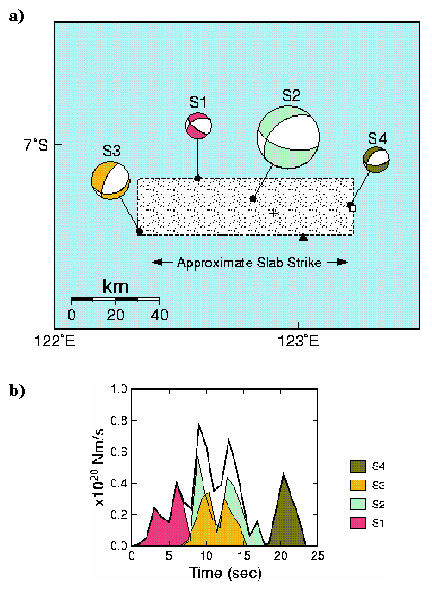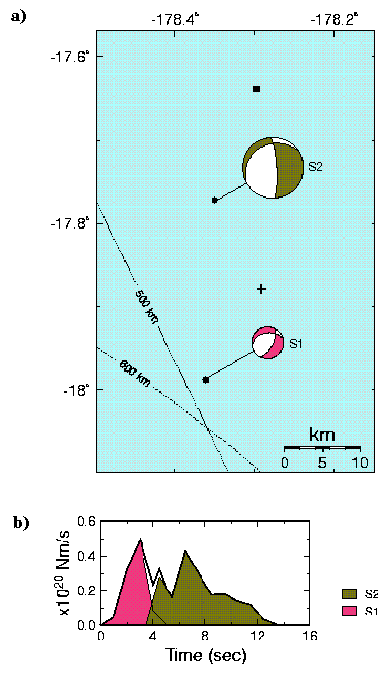Mechanisms of Deep-Focus Earthquakes
Rigobert Tibi
The mechanism responsible for deep-focus earthquakes is still a subject
of intense debate. Although deep events share similar radiation patterns
as shallow earthquakes by way of their consistency with double couple mechanism,
the rheological and thermal conditions at deeper depths inhibit generation
of pure shear faulting as a causative. The hypotheses of transformational
faulting, the favored mechanism for deep earthquakes [Green and Burnley,
1989; Kirby et al., 1991], is now seriously in question, because the lateral
extents of the deep 1994 Bolivian (~40 km x 40 km) event far exceed the predicted width for a wedge of metastable olivin in subducting slab at depth of about 650 km [Kirby et al., 1991].
The pre-requisite for a complete understanding of deep earthquakes is
the exact knowledge of the source parameters. The recent improvements in
the quality of seismic recordings through installation of global network
of broadband stations allow for detailed studies of the source processes.
The rupture histories of large deep-focus earthquakes are determined with
the aim to constrain their possible mechanisms.
The June 17, 1996, Flores Sea Event(Mw=7.9; h=587 km)
 Fig. 1. (a) Map of the epicentral area of
the June 17, 1996, Flores Sea earthquake showing locations of subevents S1, S2, S3 and S4 as derived from body-wave inversion. Triangle is the Harvard CMT centroid location. Cross is the centroid location from this study. Unfilled square is the location of the rupture termination estimated by the master-event technique. Shaded rectangle is the inferred rupture area. Focal mechanisms are lower-hemisphere projections whose areas are proportional to the seismic moment of the subevent. Filled and unfilled areas are compressional and tensional, respectively. (b) Source-time function (moment release as a function of time) for the subevents S1, S2, S3 and S4 and the whole rupture process (thick line) estimated by the body wave inversion.
Fig. 1. (a) Map of the epicentral area of
the June 17, 1996, Flores Sea earthquake showing locations of subevents S1, S2, S3 and S4 as derived from body-wave inversion. Triangle is the Harvard CMT centroid location. Cross is the centroid location from this study. Unfilled square is the location of the rupture termination estimated by the master-event technique. Shaded rectangle is the inferred rupture area. Focal mechanisms are lower-hemisphere projections whose areas are proportional to the seismic moment of the subevent. Filled and unfilled areas are compressional and tensional, respectively. (b) Source-time function (moment release as a function of time) for the subevents S1, S2, S3 and S4 and the whole rupture process (thick line) estimated by the body wave inversion.
The March 09, 1994, Fiji-Tonga Event (Mw=7.6; h=563 km)
 Fig. 2. (a) Map view of
the March 09, 1994, Fiji-Tonga event showing locations of subevents S1 and S2. Triangle is the Harvard CMT centroid location. Cross denotes the centroid location from this study. The square gives the location of the rupture termination estimated by the master-event technique. Dashed lines are the 500 and 600 km depth contours of Gudmundsson & Sambridge (1998). Focal mechanisms are lower-hemisphere projections whose areas are proportional to the seismic moment of the subevent. Filled and unfilled areas are compressional and tensional, respectively. (b) Source-time function for the 1994 Fiji-Tonga event.
Fig. 2. (a) Map view of
the March 09, 1994, Fiji-Tonga event showing locations of subevents S1 and S2. Triangle is the Harvard CMT centroid location. Cross denotes the centroid location from this study. The square gives the location of the rupture termination estimated by the master-event technique. Dashed lines are the 500 and 600 km depth contours of Gudmundsson & Sambridge (1998). Focal mechanisms are lower-hemisphere projections whose areas are proportional to the seismic moment of the subevent. Filled and unfilled areas are compressional and tensional, respectively. (b) Source-time function for the 1994 Fiji-Tonga event.
Comparison with the 1994 Bolivia Event
 Table: Comparison of inferred source parameters for the 1996 Flores Sea, 1994 Fiji-Tonga and 1994 Bolivia deep earthquakes. Values in parantheses were derived for a rectangular fault model.
Table: Comparison of inferred source parameters for the 1996 Flores Sea, 1994 Fiji-Tonga and 1994 Bolivia deep earthquakes. Values in parantheses were derived for a rectangular fault model.
Conclusions
 The Fiji-Tonga event like the Flores Sea event was characterized by high rupture velocity and moderate stress drop. The great Bolivian deep earthquake of June 1994, on the other hand, was associated with a low rupture speed and high static stress drop. The high rupture speed, low stress drop, and high seismic efficiency inferred for the Flores Sea and Fiji-Tonga events may be typical for large deep earthquakes in cold subducting slabs (see here).
The Fiji-Tonga event like the Flores Sea event was characterized by high rupture velocity and moderate stress drop. The great Bolivian deep earthquake of June 1994, on the other hand, was associated with a low rupture speed and high static stress drop. The high rupture speed, low stress drop, and high seismic efficiency inferred for the Flores Sea and Fiji-Tonga events may be typical for large deep earthquakes in cold subducting slabs (see here).
 Based on the ``runaway melting'' model of Kanamori et al. (1998) as a possible cause for the Flores Sea event it is estimated that the nonradiated energy in the Flores Sea event was sufficient to have melted a 1 cm thick layer over the whole extent of rupture. This and other arguments (Wiens, 1998) probably speak against extensive melting as a physical mechanism operating in the Flores Sea event.
Based on the ``runaway melting'' model of Kanamori et al. (1998) as a possible cause for the Flores Sea event it is estimated that the nonradiated energy in the Flores Sea event was sufficient to have melted a 1 cm thick layer over the whole extent of rupture. This and other arguments (Wiens, 1998) probably speak against extensive melting as a physical mechanism operating in the Flores Sea event.
 The fault width of the Flores Sea earthquake (~20 km) together with the fact that the rupture propagated subhorizontal and parallel to the strike of the subducting Indo-Australian plate suggest that the moment release was indeed contained within the slab core. Thus the focal process may have occured within a wedge of metastable olivine in conformity with the transformational-faulting model.
The fault width of the Flores Sea earthquake (~20 km) together with the fact that the rupture propagated subhorizontal and parallel to the strike of the subducting Indo-Australian plate suggest that the moment release was indeed contained within the slab core. Thus the focal process may have occured within a wedge of metastable olivine in conformity with the transformational-faulting model.
 However, it is not possible to put forward a similar argument for the 1994 Fiji-Tonga event. Rupture extends perpendicular to the strike of the deep seismic zone. McGuire et al. (1997) suggested that in the case of the Fiji-Tonga event several mechanisms may have been active. The nucleation phase of the event occurred in the cold core of the slab and was perhaps triggered by transformational faulting in metastable olivine. Rupture in the warmer surrounding areas may be caused by other mechanisms such as ductile faulting, plastic instabilities or frictional heating.
However, it is not possible to put forward a similar argument for the 1994 Fiji-Tonga event. Rupture extends perpendicular to the strike of the deep seismic zone. McGuire et al. (1997) suggested that in the case of the Fiji-Tonga event several mechanisms may have been active. The nucleation phase of the event occurred in the cold core of the slab and was perhaps triggered by transformational faulting in metastable olivine. Rupture in the warmer surrounding areas may be caused by other mechanisms such as ductile faulting, plastic instabilities or frictional heating.
last modification: May 02, 2000



![]()
![]()
![]()



![]()
![]()
![]()
![]()